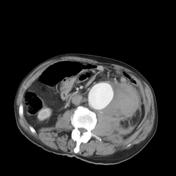5,512 results
Article
Lie classification of vasculitis
The Lie classification of vasculitis was proposed in 1994 1.
Classification
Primary vasculitides
affecting large, medium, and small blood vessels (see large vessel vasculitides)
Takayasu arteritis
temporal arteritis (giant cell arteritis)
isolated angiitis of the central nervous system
H...
Article
Fibroadipose vascular anomaly
Fibroadipose vascular anomaly (FAVA) is an intramuscular vascular anomaly consisting of phlebectasia (dilatation of veins) and fibrofatty replacement of muscle which was first described in 2014. It is in the "provisionally unclassified" category of the ISSVA classification of vascular anomalies....
Article
Bronchial artery
The bronchial arteries are the major supply of high-pressure oxygenated blood to the supporting structures of the lung, including the pulmonary arteries, but contribute only 1% of total lung blood flow. Blood in the bronchial circulation does not take part in gas exchange unless there is patholo...
Case
Azygos continuation of the inferior vena cava

Published
11 Jul 2012
65% complete
CT
Article
Aberrant right subclavian artery
Aberrant right subclavian arteries (ARSA), also known as arteria lusoria, are among the commonest aortic arch anomalies.
Epidemiology
The estimated incidence is 0.5-2% 1.
Associations
as can be expected from the embryological development of the artery, the right recurrent laryngeal nerve is...
Article
Brachiocephalic trunk
The brachiocephalic trunk (BCT) (also known as the brachiocephalic artery, and previously as the innominate artery) is the first branch of the aortic arch and supplies the head, neck and right arm.
Terminology
Although sometimes described as such, the brachiocephalic trunk is not one of the gr...
Article
Transjugular intrahepatic portosystemic shunt
Transjugular intrahepatic portosystemic shunt (TIPS or TIPSS) is a treatment for portal hypertension in which direct communication is formed between a hepatic vein and a branch of the portal vein, thus allowing some proportion of portal flow to bypass the liver. The target portosystemic gradient...
Article
Venous circle of Trolard
The anastomotic venous circle of the base of the brain 1, also referred to as the venous circle of Trolard 2,3,5, is an inconsistently found venous homologue of the better-known arterial circle of Willis.
It should not be confused with other venous structures also described by Trolard such as t...
Case
Subacute posterior inferior cerebellar artery infarct

Published
07 Feb 2022
95% complete
MRI
CT
Case
Leaking abdominal aneurysm

Published
28 Mar 2012
98% complete
Annotated image
CT
Article
Callosomarginal artery
The callosomarginal artery, also known as median artery of corpus callosum, is the largest branch of the pericallosal artery. It courses within or posterior to the cingulate sulcus, in parallel orientation to the pericallosal artery. It divides to give two or more cortical branches to supply the...
Article
Basilar artery fenestration
Basilar artery fenestration (or more simply, basilar fenestration) is the most common intracranial arterial fenestration and most common congenital anomaly of the basilar artery. This anatomic variant is characterized by duplication of a portion of the artery that are connected proximally and di...
Article
Pericardiophrenic artery
The pericardiophrenic artery, also known as the pericardiacophrenic artery, is a branch of the internal thoracic artery that runs to the diaphragm where it anastomoses with both the musculophrenic and superior phrenic arteries. It runs with the phrenic nerve and pericardiophrenic vein between th...
Case
Infected abdominal aortic aneurysm endovascular stent

Published
13 Jan 2017
95% complete
Nuclear medicine
CT
Article
Perforating veins of the lower limb
The perforating veins of the lower limb (PV or “perforators”) are so called because they perforate the deep fascia of muscles, to connect the superficial venous systems of the lower extremity with the deep veins where they drain. There are numerous veins in variable arrangement, connection, size...
Article
Subclavian artery branches (mnemonic)
Helpful mnemonics to remember the branches of the subclavian artery include:
Very Indignant Tired Individuals Sip Tasty Almond Coffee Served Double Daily
VIT C, D (as in vitamins C and D)
Mnemonics
Very Indignant Tired Individuals Sip Tasty Almond Coffee Served Double Daily
V: vertebral art...
Article
Tibioperoneal trunk
The tibioperoneal or TP trunk, occasionally referred to as the tibiofibular trunk, is the direct continuation of the popliteal artery in the posterior upper leg after the anterior tibial artery origin. It is a short trunk that bifurcates into two terminal branches.
Summary
origin: continuatio...
Case
Accessory hemiazygos vein

Published
23 Apr 2022
89% complete
CT
Case
Trigeminal neuralgia due to vertebrobasilar dolichoectasia

Published
03 Jun 2022
77% complete
MRI
Article
Contrast level within inferior vena cava
A dependent contrast level within the inferior vena cava is a situation that can be observed in some cases with inferior vena caval contrast reflux. Its presence is usually associated with very poor cardiac output and can be accompanied by dependent layering of venous refluxed contrast within th...









 Unable to process the form. Check for errors and try again.
Unable to process the form. Check for errors and try again.